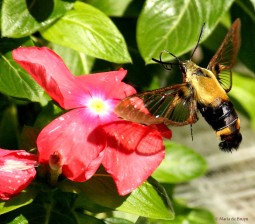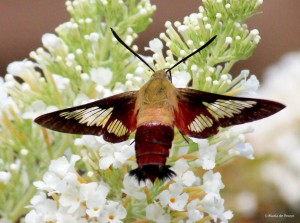 Several years ago, as I was beginning to photograph wildlife more seriously, I became quite excited at the North Carolina Botanical Garden. Buzzing around some profusely blooming flowers was what I thought might be the smallest hummingbird I had ever seen. I was not used to taking shots of something that was in almost constant motion, but I persisted until I got photos that made it at least a little recognizable. I lost the original photo when both my computer and my back-up hard drive crashed at almost the same time, but I “rescued” one of those first photos from a Word document.
Several years ago, as I was beginning to photograph wildlife more seriously, I became quite excited at the North Carolina Botanical Garden. Buzzing around some profusely blooming flowers was what I thought might be the smallest hummingbird I had ever seen. I was not used to taking shots of something that was in almost constant motion, but I persisted until I got photos that made it at least a little recognizable. I lost the original photo when both my computer and my back-up hard drive crashed at almost the same time, but I “rescued” one of those first photos from a Word document.
 I soon learned that what I had seen was actually an insect – a hummingbird clearwing moth (Hemaris thysbe) to be precise. This is likely one of the first insects that I ever got enthusiastic about.
I soon learned that what I had seen was actually an insect – a hummingbird clearwing moth (Hemaris thysbe) to be precise. This is likely one of the first insects that I ever got enthusiastic about.
I have seen a second, similar, species called the snowberry clearwing moth (Hemaris diffinis), seen below.
So, how do you tell the species apart? The snowberry clearwing has a dark band running from its eye down its throat and thorax and its legs are black, while the hummingbird clearwing lacks the thick dark band and has yellowish or paler legs.
 Some people identify these moths as bumblebee mimics, which also makes sense since they are similar in size to bumblebees. Here you see a hummingbird clearwing moth next to a silver-spotted skipper butterfly (Epargyreus clarus, one of the smaller butterflies).
Some people identify these moths as bumblebee mimics, which also makes sense since they are similar in size to bumblebees. Here you see a hummingbird clearwing moth next to a silver-spotted skipper butterfly (Epargyreus clarus, one of the smaller butterflies).
 And here you see a snowberry clearwing next to a large milkweed bug (Oncopeltus fasciatus). The adult moths are about 1.25-2 inches (3.18-5 cm) long.
And here you see a snowberry clearwing next to a large milkweed bug (Oncopeltus fasciatus). The adult moths are about 1.25-2 inches (3.18-5 cm) long.
The clearwings have an upper body color that ranges from tan to green. They are quite “furry” and have cute little tufts at their posteriors. Underneath they are pale, whitish or yellowish.
Both species have dark abdomens. The juvenile moths have dark wings but scales fall away as they mature leaving clear, transparent, panels in their wings. They would make good subjects for a stained glass artist!
Like butterflies, these moths have a long proboscis (tongue) that they can curl up when resting or during flight. The adult moths sip nectar from a variety of plants including Japanese honeysuckle, beebalm, red clover, lilacs, phlox and thistles. In my yard, they are especially fond of the butterfly bushes (Buddleja davidii), which I just discovered can be an invasive plant (so I have to keep them trimmed and make sure to lop off the dried flowers before seeds spread).
 Their caterpillars are called hornworms as they have a horn at the rear; I have not seen one yet but they must be around somewhere. They pupate in leaf litter and on the ground; since I leave the fallen leaves around, I’ve been providing them with a childhood and adolescent home! And that’s good as I really look forward now to welcoming them to my yard each year!
Their caterpillars are called hornworms as they have a horn at the rear; I have not seen one yet but they must be around somewhere. They pupate in leaf litter and on the ground; since I leave the fallen leaves around, I’ve been providing them with a childhood and adolescent home! And that’s good as I really look forward now to welcoming them to my yard each year!









I think they are really cool looking insects. The first time I saw them was at a garden in South Carolina. I hope you will see their caterpillars soon. I would love to see them, too.
LikeLike